Determining Participation in Ukraine
Survey shows what keeps Ukrainians away from clinical trials

Clinical research is an effort-intensive undertaking, with only few molecule candidates successfully reaching marketing authorization.1 The most important stakeholders in this process, apart from sponsors, scientists, and researchers, are study participants. Therefore, it is of ultimate importance to plan enrollment strategies early in order to continuously reach planned project milestones.
The following are some known detrimental consequences of non-compliance and withdrawals: higher cost of clinical trials, decreased power of results. and issues with their generalizability.2 Consequently, an increased sample size may be required to ensure statistical power and to minimize possible toxicity-related reactions in the clinical setting.3
The current trend is to move the business to emerging markets4 with deteriorating quality of healthcare5 and standards of living. Therefore, local peculiarities such as low income of participants and, often, suboptimal local public transport solutions, which may preclude patients from consenting or affect compliance, shall be analyzed.
Some studies conducted in developed countries showed that the most significant obstacles to participation in a clinical trial are: the distance to a research site6,7,8, absence of a personal car, disability, and public transport availability.9,10 Recruitment and compliance in poorer countries may also be impaired by inadequate access to medical services, low income of citizens, and logistic issues, such as inability to purchase public transport tickets, lack or inconvenience of travel solutions, and cost of tickets to be paid out-of-pocket (even if reimbursed).
The declining quality of healthcare often makes citizens seek “alternative” medical care through clinical trials network in such countries as Ukraine, despite the fact that health services provided by the state institutions are declared to be free of charge.11 The reason is that many specific procedures are unavailable through local state healthcare institutions and because most people cannot afford fee-based medical services or medical insurance.
However, apart from advantages in recruitment, sponsors may face poor compliance or low consenting rate in cases of frequent visits or intercity traveling for centralized procedures.
Few studies analyzed actual factors that have impact on participation of patients from developing countries in clinical trials. In a meta-analysis of seven studies that assessed motivation of trial subjects from India, time demands and travel were indicated as significant barriers to participation.12 In a review of difficulties related to access to cancer treatment in developing countries, researchers summarize that travel-related expenses may even preclude poor people from seeking necessary cancer treatment, not to speak of participating in clinical trials.13
A number of authors have observed positive impact of provided incentives, (e.g., expenses reimbursement14, money incentives15, and/or arrangement of transportation to research sites7,16,17,18) on recruitment rate and compliance with protocol schedule, especially in longitudinal clinical trials and/or research involving low-income participants.
Unfortunately, the identified studies were sporadic and focused on low-income or national minority populations in developed countries only, mostly observing the effect of different incentives that were not centrally and systematically offered by study sponsors, with the only reference to the prepaid taxi trips for study participants in the Management of Myelomeningocele Study (MOMS) reported by Nicholson et al.15
Therefore, the present research was an opportunity to study whether prepaid travel arrangements, alone and compared to postfactum reimbursement, have any particular effect on recruitment and retention in clinical trials conducted in countries with low income and suboptimal standards of healthcare, such as Ukraine.
Methodology
Selection of participants:
In this quantitative study, a cross-sectional anonymous survey of research site personnel who are directly engaged in informed consent process and management of research subjects was done to determine their perspectives regarding impact of travel arrangements and reimbursement of travel expenses on patients’ decision to participate in or comply with a protocol visit schedule in clinical trials conducted in the territory of Ukraine. The survey included introductory questions to confirm relevant work experience and began with a required consent page.
The researcher sent 149 invitation e-mails with the link to the survey to investigators from 109 Ukrainian sites specializing in oncology, neurology, pulmonology, and cardiology in which trial subjects’ travel and reimbursement are arranged centrally through the clinical research support company in Ukraine, the author’s employer.
Statistical analysis:
All obtained confidential data were tabulated and analyzed using descriptive statistics methods for quantitative data analysis. Mean values, including standard error of mean (SEM) from the average in the sample and p-values for some of the variables, were calculated.
The analysis of the main variables was carried out in the STATISTICA.10 (free trial version of the software was used.19 The t-test for independent samples and the single-sample z-test for the difference between two proportions (binary data) were used to analyze significance of difference in means of the groups’ scores (p-values), as discussed in more detail to follow.
In case of any discrepancies between the total numbers of prospective/enrolled participants and the subtotals of subjects from cities/regions all inconsistent replies were counted as “0”.
Results
The actual overall sites’ response rate was 52% (57 respondents took part from the 109 invitees), with the rate of complete responses received from the initial number of invitees being 41% (45 completed questionnaires). There were 12 respondents whose opinion was not collected, as they either had < 3 months of relevant experience or refused to participate.
From the 45 respondents who qualified, 34 investigators had experience in the studies with local and centrally arranged traveling, whereas 35 researchers took part in the studies with local trips of participants only.
Overall, the respondents base their opinion on communication with 1,898 prospective and actual trial subjects, from which 1,352 (71.23%) enrollees agreed to participate, with 25.38% of all the patients refused from taking part in the studies where intercity traveling to centrally performed procedures was required and 30.86% refused from participating in the studies with local traveling (Figure 1).
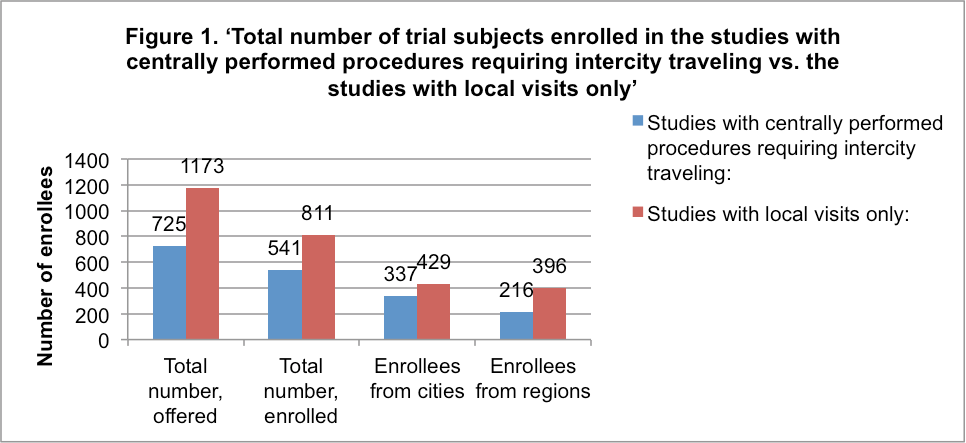
Possible difficulties (mean + SEM) associated with traveling to protocol visits that negatively impact enrolment among different groups of patients as assessed by the general group of the respondents are provided in Table 1.
Table 1 “Summary of mean responses +SEMs: difficulties associated with traveling to protocol visits that negatively impact enrollment among different groups of patients”:


To assess whether prepaid centrally arranged traveling has any positive effect on compliance as compared with postfactum reimbursement of expenses, the replies presented in Table 2 were analyzed in the single group of all 45 investigators who provided the complete questionnaire.
Table 2 “Is there a positive impact of centrally arranged traveling on compliance as compared with reimbursement of expenses?”

Therefore, the null hypothesis (H0) is that there is no significant difference between the received proportion of the “yes” replies in the sample and the hypothetical proportion in the population (“yes”/”no” = 0.5) can be rejected in the favor of the H1: there were significantly more investigators who believe that centrally arranged traveling, as compared to post-factum reimbursement of travel-related expenses, has positive effect on study participants’ compliance (95%CI [0.52 to 0.81]), with the z score = 2.24 that was obtained with the help of the single-sample z-test for the difference between two proportions” for binary data20,21,22, with the corresponding p-value = 0.025 (Table of the Standard normal probabilities / z-Table).
Due to the considerable variance in the rest of the responses, it was assumed that the respondents’ experience with different types of studies and/or with definite subjects’ groups, as well as the actual number of patients in each case possibly influenced the corresponding opinions.
Therefore, the rest of the analysis was performed both for the whole group of the investigators, regardless of their prior experience with intercity/local centrally arrange travelling (45 respondents, Group 1), and for three other adjusted groups into which the responses of the Group 1 were subdivided based on the experience in the following clinical studies, correspondingly:
a) With intercity traveling (34 respondents out of 45 total, Group 2)
b) With local traveling to protocol visits (35 respondents out of 45 total, Group 3)
c) With enrollment and compliance of disabled/elderly patients (30 respondents out of 45 total, Group 4)
There was no statistically significant difference found between the means of the proportions of different types of patients who prefer prepaid arrangements to reimbursement of expenses at the time of informed consent procedures in either of the groups (p=0.802 in the Group 1; p= 0.909 in the Group 2; p= 0.973 in the Group 3; p= 0.859, in the Group 4; see Table 3).
Table 3 “Proportions of patients who prefer prepaid traveling arrangements to postfactum reimbursement of expenses as assessed by the Groups 1, 2, 3, and 4 of the respondents”:
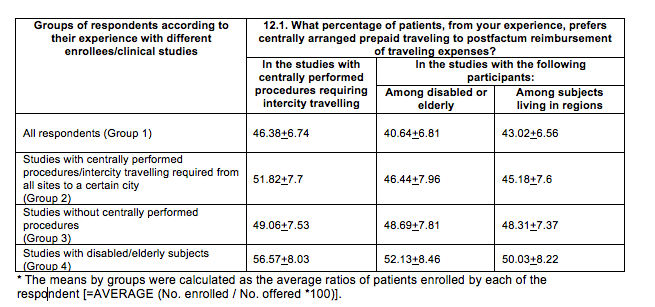
There was no significant difference (p= 0.918, SEMs +4.72 and +4.51, the t-test for independent samples, Figure 2 below) detected at the 95% confidence level between the means of the proportions of all patients enrolled into the studies with centrally performed procedures and without such procedures, as assessed by the Group 2 and the Group 3 of the respondents, respectively.
At the same time, significant difference (p=0.035, SEMs +4.84 and +4.87, respectively, the t-test for independent samples, Figure 2) was detected at the 95% confidence level between the means of the proportions of enrollees from cities and from regions in the studies with centrally arranged intercity traveling (the Group 2). There is no such trend in the studies with local traveling only based on the proportions reported in the Group 3 of respondents (p=0.375, SEMs +5.52 and +6.0).
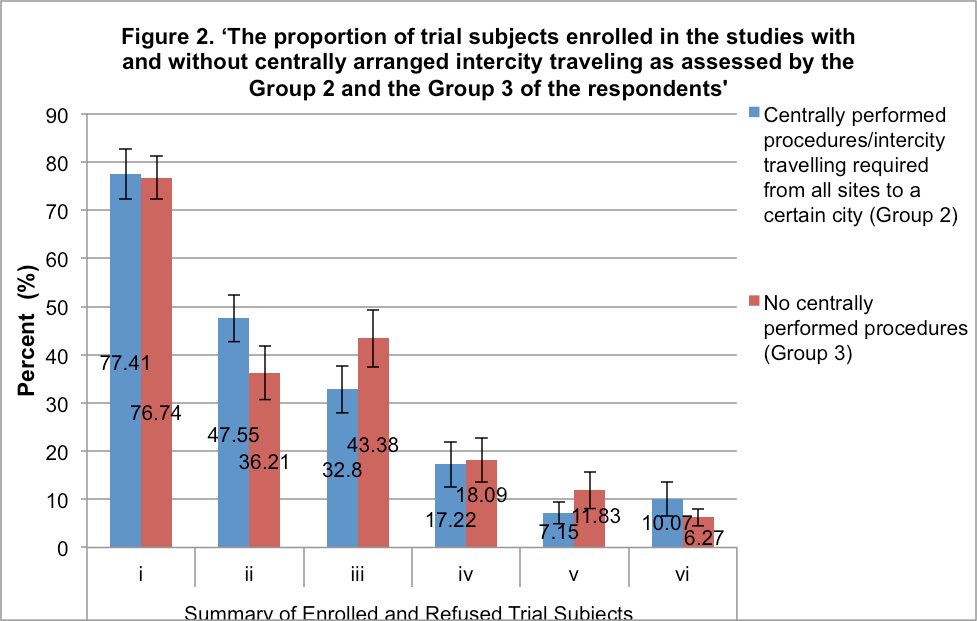
The overview of the proportions of enrollees from cities vs. patients from regions into the studies with intercity traveling as assessed by the Group 2 of respondents separately was done to evaluate influence of distance to research sites on recruitment (See Table 4). The researcher generalized some of the survey questions in order to enable classification of the responses for more efficient analysis (the therapeutic area of prospective trials was inquired instead of actual pathology).
Table 4 “Mean scores (+SEMs) of the proportions of patients enrolled into the studies with centrally arranged intercity travelingin the Group 2 of the respondents”:
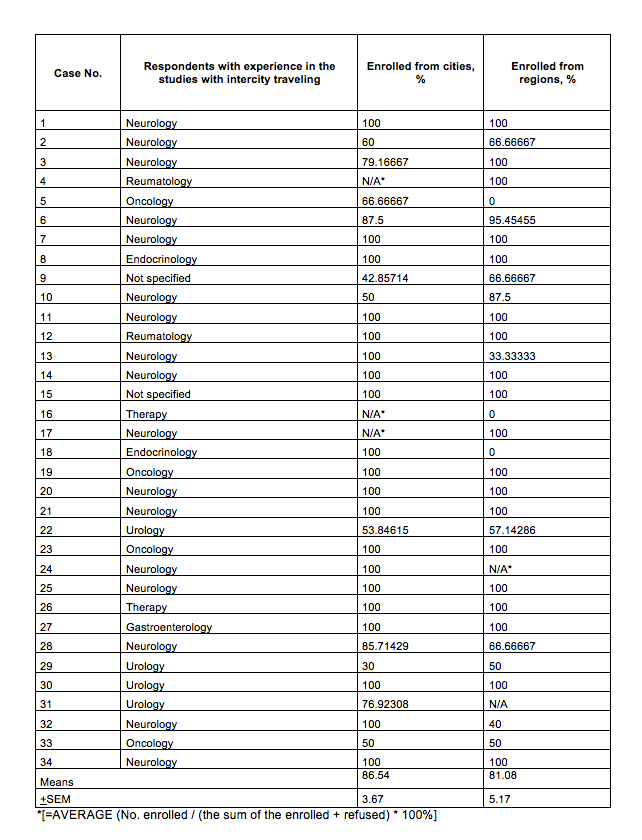
There was no significant difference between the means of the proportions of disabled/ elderly patients’ enrollment into the studies with and without centrally arranged intercity traveling (in the Group 4, see Figure 3) either in the analysis of enrollment of all disabled/elderly enrollees (p=0.579, SEMs +4.87 and +7.45, respectively, t-test for independent samples), or of the disabled/elderly enrollees from cities (p=0.248, SEMs +7.64 and +8.85, respectively) and from regions (p= 0.476, SEMs +7.46 and +9.74, respectively) in the same group of respondents.

There was no significant difference found between the scores in the subgroup of elderly/disabled subjects from cities and the subgroup of all other subjects from regions (Figure 4) who refused from participation in the studies with local traveling only because of difficulties associated with traveling to protocol visits (p=0.831, SEMs +3.69 and +3.79; p=0.821, SEMs +4.65 and +4.04; and p=0.941, SEMs +5.21 and +5.48 for the Groups 1, 3, and 4, respectively).
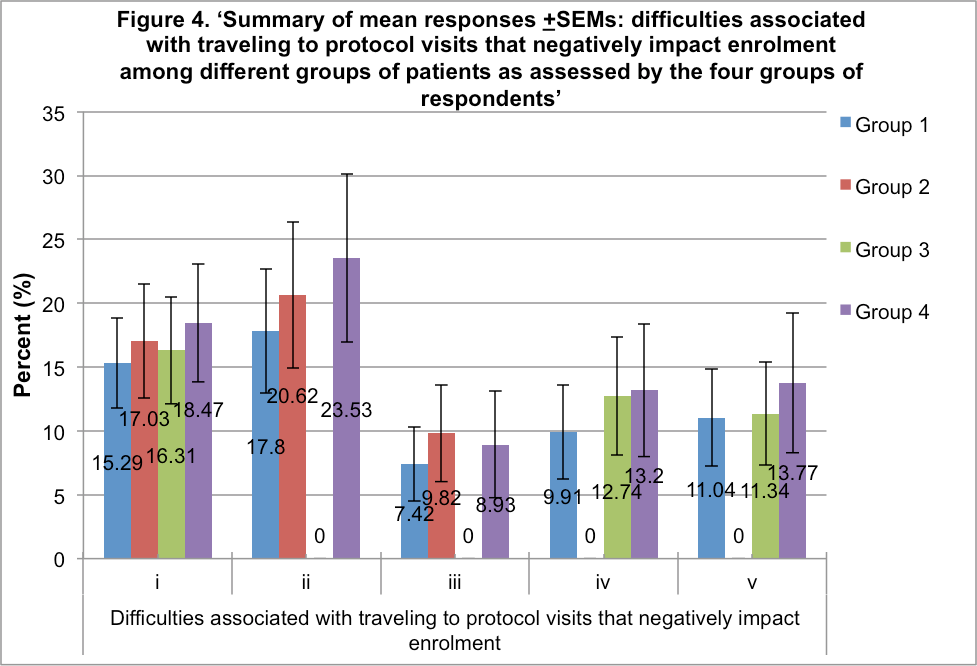
There were no statistically significant differences detected between the specified travel-related causes of protocol deviations due to postponed/cancelled visits in the four groups of the respondents (SEMs for the 4 Groups, respectively; presented in Figure 5).
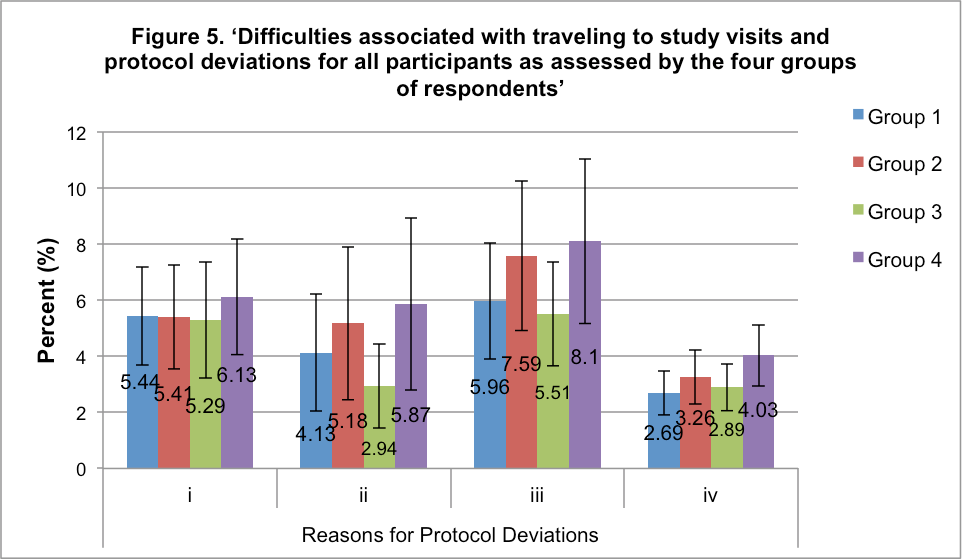
In order to assess whether certain pathology has impact on recruitment, the responses in the group of researchers with specialization in neurology and rheumatology were evaluated, as this was the largest group of respondents (20 and six investigators, respectively; Table 5 and Table 5.a).
Table 5 “Difficulties associated with traveling to study visits that lead to refusal from participation as assessed by the respondents with specialization in neurology”:
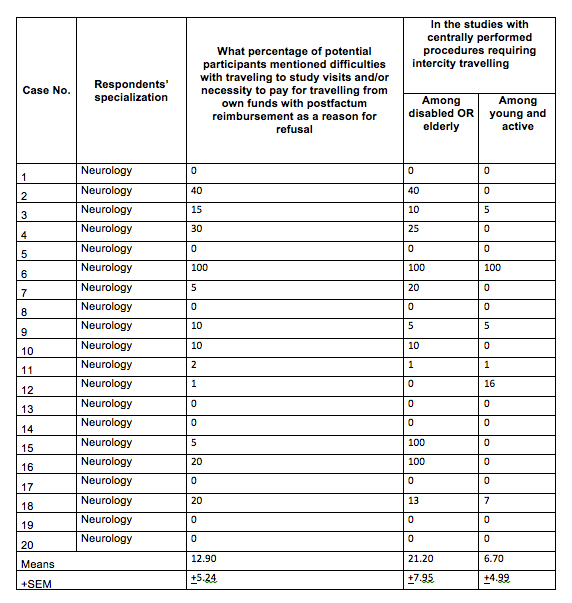
Table 5.a. “Difficulties associated with traveling to study visits that lead to refusal from participation as assessed by the respondents with specialization in rheumatology”:
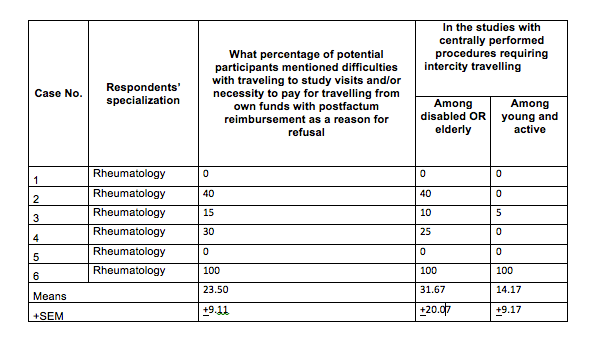
There was no significant difference between the means of proportions of all patients who refused to participate in any of the groups (SEMs +5.24 and +9.11, p = 0.336). However, taking into account the large SEMs in both groups and a small sample size, it may be assumed that a study profile/site specialization and pathology have certain impact on recruitment.
Discussion
The aim of the present study was to evaluate whether centrally arranged prepaid travel arrangements, alone and compared to reimbursement of expenses, lead to better rates of recruitment and compliance, as well as to assess the role of different factors such as distance to a research site, disability, and specific disease in recruitment/compliance in any particular groups of patients for whom travel provisions are made.
Effect of prepaid traveling on compliance:
From the experience of the investigators who are directly involved in follow-up of trial subjects’ participation in clinical trials, there is a positive effect of prepaid centrally arranged traveling on subjects’ compliance (at the 95% confidence level, p<0.05; Table 2).
Effect of prepaid traveling on recruitment:
There was no statistically significant difference found between the means of the proportions of different types of patients who prefer prepaid arrangements to reimbursement of expenses at the time of informed consent procedures in the following groups: 1) fractions of the Group 4 from cities/regions were compared with all other enrolled patients from regions, and 2) proportions of all patients in the studies with and without centrally performed procedures were compared between the Group 2 and 3.
At the same time, significantly more patients from cities were enrolled into the studies with intercity traveling for centralized procedures. This may be indicative of difficulties related to arrangement of intercity traveling by subjects from regions.
Influence of disability on recruitment:
The present study did not reveal any difference between either the proportions of all subgroups within the Group 4 (Figure 3) alone or compared to all other patients from regions (Figure 4); however. there is a trend toward higher percentage of refusals from participation in the studies with intercity traveling in the disabled/elderly patients’ group when compared to the group of active/young patients (p=0.07, t-test for independent samples, the Group 1 of respondents). The trend toward significance was also found in the analysis of the responses to the same question in the Group 2 (p=0.12, Figure 4) and the Group 4 (p=0.066, Figure 4) of the investigators.
Though there is no unanimous decision among statisticians in clinical research as to whether a p-value >0.05 and <0.1 should be accepted as a trend indicating probable significant result when assessing data post hoc23, further research with greater number of participants and with inclusion of prospective trial subjects’ opinions might yield important results.
Influence of pathology on recruitment:
No statistical difference was found between the means of proportions of the patients who refused to participate in any of the groups (p = 0.336). However, further studies may be useful to confirm whether a study profile/site specialization and pathology have certain impact on recruitment, taking into account variability of opinions and a small sample size of the respondents.
Influence of distance to research sites on recruitment:
No significant difference was detected at the 95% confidence level between the means of the proportions of enrollees from cities and from regions recruited into the studies with centrally performed procedures requiring intercity travel (p=0.392, the t-test for independent samples), therefore greater distance to hospital was reported as not having a negative impact on recruitment into the studies with intercity traveling involved (Table 4).
Conclusions
The results obtained in this study indicate that trial burdens, including out-of-pocket expenses, appear to have a negative effect on compliance of patients from Ukraine. This is supported by the fact that the investigators reported better compliance with visits schedule in studies with prepaid centrally arranged traveling. To retain patients in a study, it might be beneficial for sponsors to assess impact of such burdens in advance and to offer optimal travel solutions to prospective participants (e.g., dedicated questionnaires for trial participants from developing countries who refuse to participate or withdraw their consents could be used for early modification of a recruitment and retention strategy).
Centrally arranged prepaid travel seem not to be preferred to post factum reimbursement of expenses at the time of decision making by prospective participants, as assessed by investigators who conducted the informed consent procedure. The obtained outcomes with respect to recruitment, however, may be biased by the fact that participation in clinical trials is often the only chance for many patients from Ukraine to get access to quality healthcare and future demands of a trial may be underestimated, presumably affecting compliance with a study visit schedule later.
Unfortunately, it is not uncommon for Ukrainian investigators to believe that “extra benefits” that “result” from participation in a clinical trial ensure that patients will find a way to comply with a study protocol schedule, whereas availability of reimbursements and/or prepaid travel is often not revealed to prospective patients due to investigators’ concern that such arrangements might require considerable efforts and time expenditures from study staff.
On the other hand, prospective participants often accept study demands during the informed consent process, being unable to coop with them later due to financial difficulties and considerable time commitments needed to comply with protocol schedules. This leads to undesirable costly consequences such as incompliance and dropouts.
In general, the major limitations of the present study include: the results represent perspectives of investigators who are, nonetheless, directly engaged in recruitment and clinical trial subjects’ management, the moderate number of complete responses, and possible recall bias. The high response rate in the sample and the highly specific questionnaire structure aimed to alleviate the mentioned types of bias. Additionally, as the research was conducted in a previously unstudied area it offers important insight and supports a need for further studies.
Nataliia Vietchinkina, MSc Clinical Research Administration, University of Liverpool
References
1. Leeson, P. (2012) “Drug discovery: Chemical beauty contest”, Nature, 481, pp. 455–456 [Online]. Available from: http://dx.doi.org.ezproxy.liv.ac.uk/10.1038/481455a (Accessed: 18 August 2012).
2. Westhoff, C.L. et al. (2012) “Predictors of noncompliance in an oral contraceptive clinical trial”, Contraception, 85 (5), May, pp. 465-469 [Online]. Available from: http://dx.doi.org.ezproxy.liv.ac.uk/10.1016/j.contraception.2011.09.019 (Accessed: 13 August 2012).
3. Melnikow, J. and Kiefe, C. (1994) “Patient compliance and medical research: Issues in methodology”, Journal of General Internal Medicine, 9 (2), pp. 96-105 [Online]. Available from: http://dx.doi.org.ezproxy.liv.ac.uk/10.1007/BF02600211 (Accessed: 13 August 2011).
4. HHS /U.S. Department of Health and Human Services (2010) Challenges to FDA’s Ability to Monitor and Inspect Foreign Clinical Trials [Online]. Available from: https://oig.hhs.gov/oei/reports/oei-01-08-00510.pdf (Accessed: 01 November 2012).
5. Petryna, A. (2007) “Clinical Trials Offshored: On Private Sector Science and Public Health”, BioSocieties, 2, pp. 21–40 [Online]. Available from: http://dx.doi.org.ezproxy.liv.ac.uk/10.1017/S1745855207005030 (Accessed: 01 November 2012).
6. Ross, S. at al. (1999) “Barriers to Participation in Randomized Controlled Trials: A Systematic Review”, Journal of Clinical Epidemiology, 52 (12), December, pp. 1143–1156 [Online]. Available from: http://dx.doi.org.ezproxy.liv.ac.uk/10.1016/S0895-4356(99)00141-9 (Accessed: 18 August 2012).
7. Diener-West, M., Hawkins, B.S., Moy, C.S., and Earle, J.D. (2001) “Sociodemographic and Clinical Predictors of Participation in Two Randomized Trials: Findings from the Collaborative Ocular Melanoma Study COMS Report No. 7”, Controlled Clinical Trials, 22 (5), October, pp. 526-537 [Online]. Available from: http://dx.doi.org.ezproxy.liv.ac.uk/10.1016/S0197-2456(01)00157-X (Accessed: 03 August 2012).
8. LaVallie, D.L., Wolf, F.M., Jacobsen, C., Buchwald, D. (2008) “Barriers to cancer clinical trial participation among Native elders”, Ethnicity & Disease, Spring, 18(2), pp. 210-7 [Online]. Available from: http://www.ncbi.nlm.nih.gov/pubmed/18507276 (Accessed: 10 February 2013).
9. Aitken, L., Gallagher, R, Madronio, C. (2003) “Principles of recruitment and retention in clinical trials”, International Journal of Nursing Practice, 9, pp. 338–346 [Online]. Available from: http://onlinelibrary.wiley.com.ezproxy.liv.ac.uk/doi/10.1046/j.1440-172X.2003.00449.x/pdf (Accessed: 03 August 2011).
10. Wynn, L. et al. (2010) “Recruitment of infants with sickle cell anemia to a Phase III trial: Data from the BABY HUG study”, Contemporary Clinical Trials, 31, pp. 558–563 [Online]. Available from: http://dx.doi.org.ezproxy.liv.ac.uk/10.1016/j.cct.2010.08.007 (Accessed: 15 November 2012).
11. Parliament of Ukraine (1996) “Constitution of Ukraine: the Law â 254к/96-ÐÐ dated 28.06.1996”, State Paper of the Parliament of Ukraine, 30, p. 141 [Online]. Available from: http://static.rada.gov.ua/site/const_eng/constitution_eng.htm#c2 (Accessed: 01 November 2012).
12. Shah, J.Y. et al. (2010) ‘What Leads Indians to Participate in Clinical Trials? A Meta-Analysis of Qualitative Studies, A Meta-Analysis of Qualitative Studies’, PLoS ONE, 5(5): e10730 [Online]. Available from: http://dx.doi.org.ezproxy.liv.ac.uk/10.1371/journal.pone.0010730 (Accessed: 18 November 2012).
13. Hanna, T.P. and Kangolle, A.CT. (2010) “Cancer control in developing countries: using health data and health services research to measure and improve access, quality and efficiency”, BMC International Health and Human Rights, 10:24 [Online]. Available from: http://dx.doi.org.ezproxy.liv.ac.uk/10.1186/1472-698X-10-24 (Accessed: 12 December 2012).
14. Baquet, C.R., Commiskey, P., Mullins, C.D., Mishra, S.I. (2006) “Recruitment and participation in clinical trials: Socio-demographic, rural/urban, and healthcare access predictors”, Cancer Detection and Prevention, 30 (1), pp. 24-33 [Online]. Available from: http://dx.doi.org.ezproxy.liv.ac.uk/10.1016/j.cdp.2005.12.001 (Accessed: 03 August 2012).
15. Nicholson, L.M. et al. (2011) “Recruitment and retention strategies in longitudinal clinical studies with low-income populations”, Contemporary Clinical Trials, 32, pp. 353-362 [Online]. Available from: http://dx.doi.org/10.1016/j.cct.2011.01.007 (Accessed: 03 August 2012).
16. Richardson, M.A., Post-White, J., Singletary, S.E., Justice, B. (1998) “Recruitment for complementary/alternative medicine trials: Who participates after breast cancer”, Annals of Behavioral Medicine, 20 (3), pp. 190–198 [Online]. Available from: http://dx.doi.org.ezproxy.liv.ac.uk/10.1007/BF02884960 (Accessed: 03 August 2012).
17. Linga, J.,Reesb, E., Hardyb, J. (2000) “What influences participation in clinical trials in palliative care in a cancer centre?”, European Journal of Cancer, 36 (5), March, pp. 621-626 [Online]. Available from: http://dx.doi.org.ezproxy.liv.ac.uk/10.1016/S0959-8049(99)00330-5 (Accessed: 14 August 2012).
18. Pathman, D.E., Konrad, T.R., Schwartz, R. (2001) The Proximity of Rural African American and Hispanic/Latino Communities to Physicians and Hospital Services [Online]. North Carolina Rural Health Research and Policy Analysis Center, Cecil G. Sheps Center for Health Services Research, The University of North Carolina at Chapel Hill. Available from: www.shepscenter.unc.edu/rural/pubs/report/wp72.pdf (Accessed: 14 August 2012).
19. StatSoft (2013) Request STATISTICA 10 Software Trial [Online]. Available from: http://www.statsoft.com/support/free-statistica-10-trial/ (Accessed: 01 February 2013).
20. Feinstein, A.R. (2002) Principles of Medical Statistics. New York: Chapman and Hall/CRC.
21. Newsome, J.T. (2013) Portland State University, Lecture notes from USP 634 Data Analysis: Spring 2013 Course ‘Single-Group Statistical Tests with a Binary Dependent Variable’ [Online]. Available from: http://www.upa.pdx.edu/IOA/newsom/da1/ho_z-test.pdf (Accessed: 18 Aug 2014).
22. LeBlanc, D.C. (2004) Statistics: Concepts and Applications for Science, Vol. 2. Sudbury: Jones and Bartlett Publishers, Inc., pp. 171-175.
23. Bangalore, S., Messerli, F. (2006) “Of Statistical Significance: Trends Toward Significance and Optimism Bias”, Journal of the American College of Cardiology, 48(7), October, p. 1471 [Online]. Available from: http://dx.doi.org.ezproxy.liv.ac.uk/10.1016/j.jacc.2006.07.011 (Accessed: 05 February 2013).
Unifying Industry to Better Understand GCP Guidance
May 7th 2025In this episode of the Applied Clinical Trials Podcast, David Nickerson, head of clinical quality management at EMD Serono; and Arlene Lee, director of product management, data quality & risk management solutions at Medidata, discuss the newest ICH E6(R3) GCP guidelines as well as how TransCelerate and ACRO have partnered to help stakeholders better acclimate to these guidelines.
Putting Collective Insights Into Action to Advance Cancer Care: Key Examples From ASCO 2025
June 27th 2025At ASCO 2025, clinical operations leaders gained critical insights into how AI tools, bispecific antibodies, and evolving treatment paradigms are reshaping trial design, endpoint selection, and patient stratification.